Radish Farming: A step by step guide
Well, today we learn the farming of radish, planting, care, harvesting techniques, tips, and ideas.
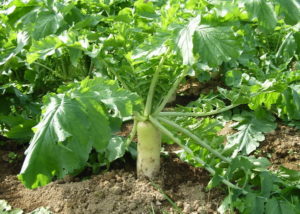
Introduction to Radish:
Radish is a popular vegetable in both tropical as well as temperate regions. Being a quick growing crop it can be easily planted as a companion crop or intercrop between the rows of the other vegetables. It can also be planted on ridges, separating one plot from another. It is cultivated all over India, especially near the city markets. Radish originated probably in China. In India, it seems to have been cultivated from ancient times. It was popular among the ancient Egyptians and Greeks.
The botanical name of radish is “Raphanus sativus”. The enlarged edible roots are fusiform and differ in color from white to red. There are two distinct genetical groups in radish. The Asiatic varieties, which are primarily for tropical climates, produce edible roots in the first season and seed in the second season as a biennial crop. On the other hand, the exotic or European varieties produce roots in the plains of tropical and subtropical climate and seeds in the hills of temperate climate.
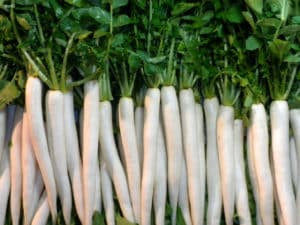
First and Foremost, you should have an idea of local varieties of radish, accordingly, you start your Radish Farming.
You may be interested in reading Brinjal Farming Profit, Cost.
Some facts about Radish plantation and growing:
- If you are growing radishes from seeds, they usually germinate within 5 to 8 days depending on moisture level.
- Radishes can be grown in pots or containers. Easy to grow on the terrace, raised beds, backyards, and balconies.
- Radishes can be grown indoors with proper growing conditions.
- Radish takes 4 to 5 weeks to get the first harvest after planting.
- Radishes can be regenerated from roots and easily be grown from scraps.
- Radish grows well in cooler climates but requires good sunlight.
- If your radishes are not growing because of overcrowding.
- Soil is important for radish root crop, usually, radishes prefer fertile, well-drained, sandy soils (deep) with good organic matter.
- It is always a good idea of adding compost if you are growing radish in pots/containers.
- Radish requires at least 1 inch of water per week depending on soil moisture, don’t overwater or don’t allow the soil to dry completely.
- The reason for the radish split is that you left them on the ground for a long time.
- Along with micronutrients, radishes require well-balanced N:P:K (Nitrogen, Phosphorus, and Potassium).
Improved varieties of Radish:
A large number of varieties indigenous as well as introduced are cultivated in the different regions of India. The indigenous varieties are usually white with a conical shape, attaining 25-40 cm in length and are said to be more pungent than the introduced European types. European types are not very common and popular in India. Important characteristics of some of the recommended varieties are given below
-
Pusa Reshmi
The roots are 30-45 cm long with white green tinge on top. It is suitable for early sowing during winter, but it can tolerate a slightly higher temperature. Good sized roots are ready for harvesting in about 55 to 60 days.
-
Pusa Desi
It is a tropical and subtropical cultivar suitable for growing from the middle of August to October in the northern plains. Roots are pure white, 30-35 cm long, tapering with green stem, pungent and heavy yielder. It matures in 50-55 days after sowing.
-
Arka Nishant
This variety has been developed at IIHR, Bangalore. It matures in 45 -55 days. Roots are medium sized, marble white, crisp texture, pleasant aroma, free from early bolting, pithiness, splitting, and forking. Each root weighs about 300-400 g. It is pungent and yields about 200 -300 quintals of fresh radish per hectare.
-
Pusa Himani
The roots of Pusa Himani are 30-35 cm long and 10-12 cm in girth with green stemmed. They are semi-stumped to tapering with short stalks. The skin is pure white and the flesh is soft and sweet flavored with mild pungency. Though it is primarily a variety for hilly region, it has been found to do well in the milder climate of the plains also.
-
Chinese Pink
The skin is shining red, and the flesh is white, crisp, solid and mildly pungent. The roots are 30-40 cm long with a semi-blunt end.
The top is medium. It is a good cultivar for the hills but can be grown in plains with a mild climate. It requires low temperature for seed production.
-
Pusa Chetki
It has been developed at IARI, New Delhi. Roots are medium long, white, good textured, weighing 300 -400 g each. Since it can tolerate high temperature, it is suitable for sowing from the middle of March to middle of August. This cultivar sets seeds properly in the plains because it bolts very early in the plains during October- November. It yields about 200 -250 quintals fresh radish per hectare.
-
Punjab Safed
Radish roots are white tapering, smooth, mild in taste, free of forking, 30 to 40 cm in length and 3 -5 cm thick. It is a quickly growing type.
-
Japanese White
It has been developed at IARI, New Delhi. The roots are cylindrical, 22 -25 cm in length and 5 cm in diameter. The skin is snow white, flesh crisp, solid and mildly flavored. It matures in 45 days.
It is suitable for growing between October and December in plains and from July to September in hills.
-
IHR-I-I
Roots are thin, about 30 cm long, free from premature bolting, pithiness, splitting, and forking. Roots are mildly pungent, each weighing about 300 gm. Root surface is smooth, shining and white. It is highly resistant to white rust and takes about 45 days to reach harvesting maturity.
-
Kalyani White
Roots are pure white with a blunt end, uniform in size, 25 -30 cm length. It is a mildly pungent cultivar with a light top. It can be grown throughout the year except for a few months during the summer. It takes about 45-50 days to reach edible maturity.
-
White Icicle
It is a medium – short European variety which matures in 30 days. The skin is pure white, thin and tender, whereas the flesh is icy-white, crisp, juicy, mild and sweet flavored with just enough, pungency to appeal the appetite. The root is a solid icicle shaped straight and tapered. It has given a good harvest in the plains.
-
Rapid Red White Tipped
It is an extra European type which matures in 25-30 days. The roots are smooth, small, round and bright red with white tip. The flesh is pure white, crisp and snappy.
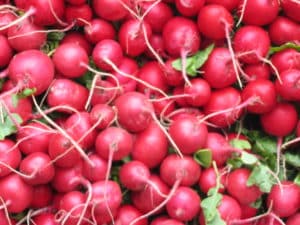
You may also check the Poplar Tree Plantation, Spacing, Harvesting.
Local Indian Names for Radish:
Mooli (Hindi), Mullangi (Tamil), Mullangi (Telugu),Moolangi (Kannada), and Mula (Marathi).
The climatic condition required for growing Radish
Usually radish is a cool season crop but the Asiatic varieties can resist more heat than the European or temperate varieties. It attains best flavor, texture, and size at 10 to 15°C. Long days, as well as high temperature, lead to bolting without adequate root formation. During the hot weather, the root becomes tough and pungent before reaching the edible size and, therefore, the crop should be harvested while young and small in size. The radish is more pungent at a higher temperature. Pungency decreases with a cooler temperature.
Suitable Soil for Radish plantation
Radish grows in any type of well drained and loose soil. Till the soil to a depth of 6-8 inches to make it lose and more suitable for growing radish. Add a layer of farmyard manure (FMY) or garden compost to enrich it with organic matter. Soils with a pH range of 6.0 – 7.5 are more suitable for radish farming.
Land Preparation for Radish plantation:
Soils should be plowed to a depth of 30-40 cm to provide fine tilth. The soil for radish is thoroughly prepared so that there are no clods to interfere with root development. The soil should not contain any undecomposed organic matter because that may result in forking of roots or misshapen roots. Generally, first plowing, about 30 cm deep, is done with soil turning plow and remaining 5 -10 ploughings are done with desi plow. Each plowing should be followed by planking. Application of farmyard manure (FMY) should preferably be done at the time of first plowing.
Soil sterilization for growing Radish:
The sterilization of the soil can be achieved by both physical and chemical means. Physical control measures include treatments with steam and solar energy. Chemical control methods include treatments with herbicides and fumigants. Soil sterilization can also be achieved by using transparent plastic mulch film, which is termed as soil solarization. During soil solarization, the incoming solar radiation penetrates the transparent plastic film and is absorbed in the soil. The absorbed radiation converts into heat energy, which raises the soil temperature and kills many soil-borne organisms including plant pathogens and pests.
Seed Rate and Seed Treatment of Radish:
Radish seeds count about l05-125 seeds per gram. About 10-12 kg seed will be sufficient for sowing in one hectare of land. It has been found that soaking radish seeds in Naphthaline acetic acid (NAA) at. 10-20 ppm before sowing is effective in stimulating germination of radish seeds.
Best Sowing time of Radish:
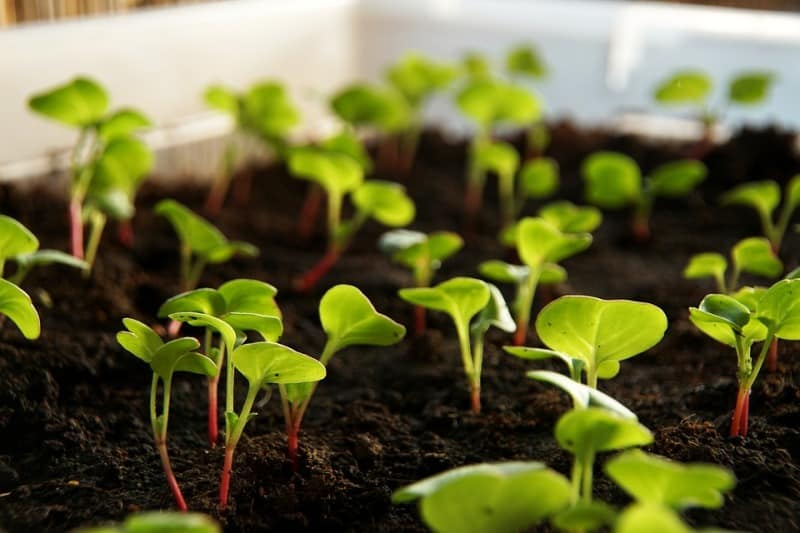
Since radish is a cool season crop, its cultivation is prepared during the winter season in the plains. It can be sown at any time between September and January in northern plains as it is not affected either by frost or by extremely cold weather condition. It is grown from March to August in the hills. In the regions where summer is mild, it can be grown throughout the year, except for a few months of summer. In Bangalore, radish roots are available for 8-10 months of the year but the best edible roots are available during November-December only. The temperate types are generally not planted till October.
Radish sowing methods:
Radish is usually grown on ridges to facilitate good root production. It is grown, as a single crop or as a companion crop. The plant rows or ridges about 22 cm high are kept about 45 cm apart, whereas the plants within the rows are kept 8 cm apart. The European or temperate types, as they need closer spacing, can be sown 20 -30 cm apart. Generally, the seed sowing is done 1.15 cm deep. The seed is sown by any of the two methods namely line sowing and broadcasting. There are two types of Sowing in Radish Farming
Line sowing: Seed is mixed with sand or soil in the ratio of 1:4 and placed in a row by hand, over the ridges and then covered with Soil.
Broadcasting: Seed is mixed with sand or soil in a ratio of 1:4 and scattered over the field, as even as possible, followed by planking. Plants are spaced after germination while hoeing.
You may also check the Kadaknath Egg Production.
Planting and Spacing of Radish:
- Dibble in rows on raised beds.
- Spacing – 25-30 cm between rows; 10 cm between plants.
- Spacing for table radish – 20 cm X 5 cm.
- Plant 2 seeds per hill and thin out one at germination.
Water requirement for growing Radish:
Radish plants need regular watering to keep the soil moist. Irrigate daily for the first 4-5 days; then every 3-4 days depending on rainfall. In dry soil conditions, radish tends to bolt and tastes bitter (too pungent). But do not overwater otherwise root will rot and split. Depending upon the season and the soil moisture availability, radish may be irrigated.
Application of manures and fertilizers for Radish Plants:
The farmyard manure should be mixed up thoroughly at the time of field preparation, whereas the complete doses of potassic phosphatic and one-half dose of nitrogenous fertilizers can be applied in the rows before sowing. The remaining half dose of nitrogenous fertilizers should be applied as a top dressing along with irrigation when the plants start growing vigorously. Radish is a quick-growing crop, hence the soil should be highly rich in plant nutrients. Add farmyard manure 25-40 tonnes, nitrogen 18-50 kg in the form of ammonium sulfate, phosphorus 50 kg in the form of superphosphate and potash 50 kg in the form of Muriate of potash for one hectare of the field.
Weed control in Radish plantation:
Regular weeding in Radish Farming is necessary to see the growth of the weeds. In the rainy season, two weedings will be required to keep the growth of weeds under control. Tok E -25 (Nitrofan 25%) applied as pre-emergence, controls both monocot as well as dicot weeds in radish field. One earthing up and one weeding during the early stages of radish growth are necessary for developing the roots. Radish has a tendency to bulge out of the soil as it grows in size. Therefore, thorough covering by earthing up is recommended to produce quality roots. For seed crop, a second earthing up during flowering and fruiting is advocated to prevent lodging of the Radish plants.
Pests and Diseases of Radish:
Below are the main Pests and Disease found in Radish Farming:
Disease
Clubroot
Symptom: Swelling/ malformation on the main root and laterals
Stunted growth
Control
- Raise soil pH with a heavy dressing of lime
- Avoid continuous cropping of crucifers
- Keep the field free of wild mustard
Pests:
Leaf-eating caterpillars
Control: Apply chlorofluazuran, Quinalphos, Profenophos, Eteofenprox or neem seed water extract.
Vegetable leaf miner – Liriomyza huidobrensis
(Diptera: Agromyzidae)
Note: Please contact your nearest agriculture department for all Pest and Disease control Information on radish farming.
You may also read the Advantages of Green Leaf Manuring.
Planting Tips of Radish:
The best way to grow a radish is by planting seeds outside early in the spring. Radishes are the first vegetable to be harvested in a garden, so planting early is the key. The best way to grow a radish is to plant the seeds half an inch deep and one inch apart in a row. The plants will come up within the next four to six days. When growing radish from seed, make sure you plant seeds eight to ten days apart so you can have a steady supply.
One of the best radish planting tips is to keep your garden free of weeds. Weeds rob your radishes of nutrients as they grow, and you won’t have good radishes if you allow weeds to take over your garden. Make sure when growing radish from seed that you keep the soil from crusting around the plants. This helps the radish become larger.
Harvesting of Radish:
In Radish Farming, harvesting time is an important factor in growing radish. If you leave radish in the ground for too long then it becomes inedible. Generally, the crop can be harvested from 3rdweek of sowing seeds. Matured radish can be identified by large leaves above the ground on 2-3 cm wide top. Pull the mature radish out of the ground and cut off the lush green top. Store the harvested crop in the refrigerator and use within a week. In order to save seeds for next season leave the radish in the ground and let it flower and fruit.
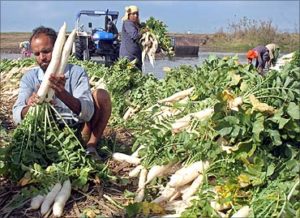
The yield of Radish:
The European or temperate varieties produce 80 -100 quintals roots per hectare in 25 -30 days. whereas the Asiatic improved Radish varieties produce 150-250 quintals roots per hectare in 40-60 days.
Marketing of Radish:
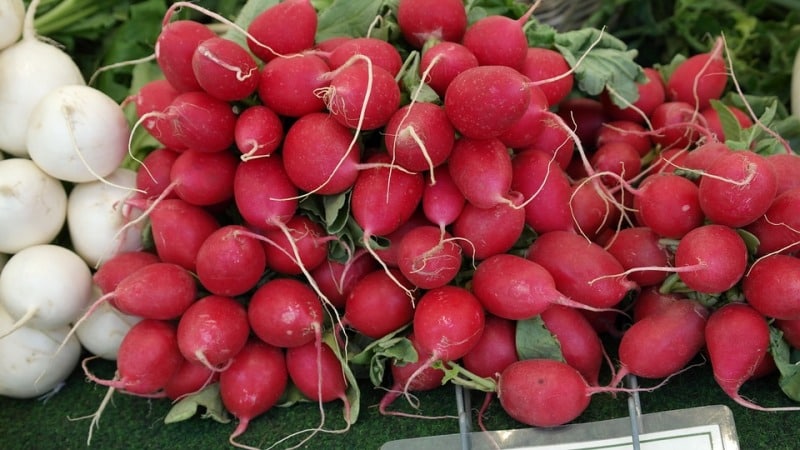
Trucks can be used to transport Radish to local vegetable markets.
Bottom Line about Radish Farming:- It’s profitable farming with a low initial investment.
You may be interested to read Growing Basil from Cuttings, Seeds.
Cost of cultivation of radish.
Nice informative site about vegetables especially.